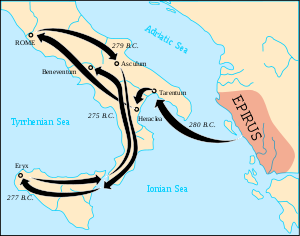Our website is made possible by displaying online advertisements to our visitors.
Please consider supporting us by disabling your ad blocker.
Battle of Asculum
This article has multiple issues. Please help improve it or discuss these issues on the talk page. (Learn how and when to remove these messages)
|
| Battle of Asculum | |||||||
|---|---|---|---|---|---|---|---|
| Part of the Pyrrhic War | |||||||
 Battle sites and places of the Pyrrhic War | |||||||
| |||||||
| Belligerents | |||||||
|
| |||||||
| Commanders and leaders | |||||||
|
Publius Decius Mus Publius Sulpicius Saverrio | Pyrrhos I | ||||||
| Strength | |||||||
|
| ||||||
| Casualties and losses | |||||||
| 6,000 killed | 3,500 killed | ||||||
The Battle of Asculum[2] was a poorly documented battle that took place near Asculum (modern Ascoli Satriano) in 279 BC, and was thought to have lasted either one or two days, between the Roman Republic under the command of the consuls Publius Decius Mus (who by some accounts died before the battle) and Publius Sulpicius Saverrio, and the forces of King Pyrrhus of Epirus. The battle took place during the Pyrrhic War, after the Battle of Heraclea of 280 BC, which was the first battle of the war. There currently exists accounts of this battle only by three ancient historians: Dionysius of Halicarnassus, Plutarch, and Cassius Dio, although these historians in turn reference other historians whose work is now lost. Asculum was in Lucanian territory, in southern Italy. The Battle of Asculum was the original "Pyrrhic victory". The result of the battle is not definitively known, with Plutarch stating that it was a pyrrhic Greek victory, Cassius Dio recording it as a Roman victory. The constituents of both armies are also poorly known, with each historian offering largely divergent estimates for the strength of the armies or the length of the battle.
Previous Page Next Page


